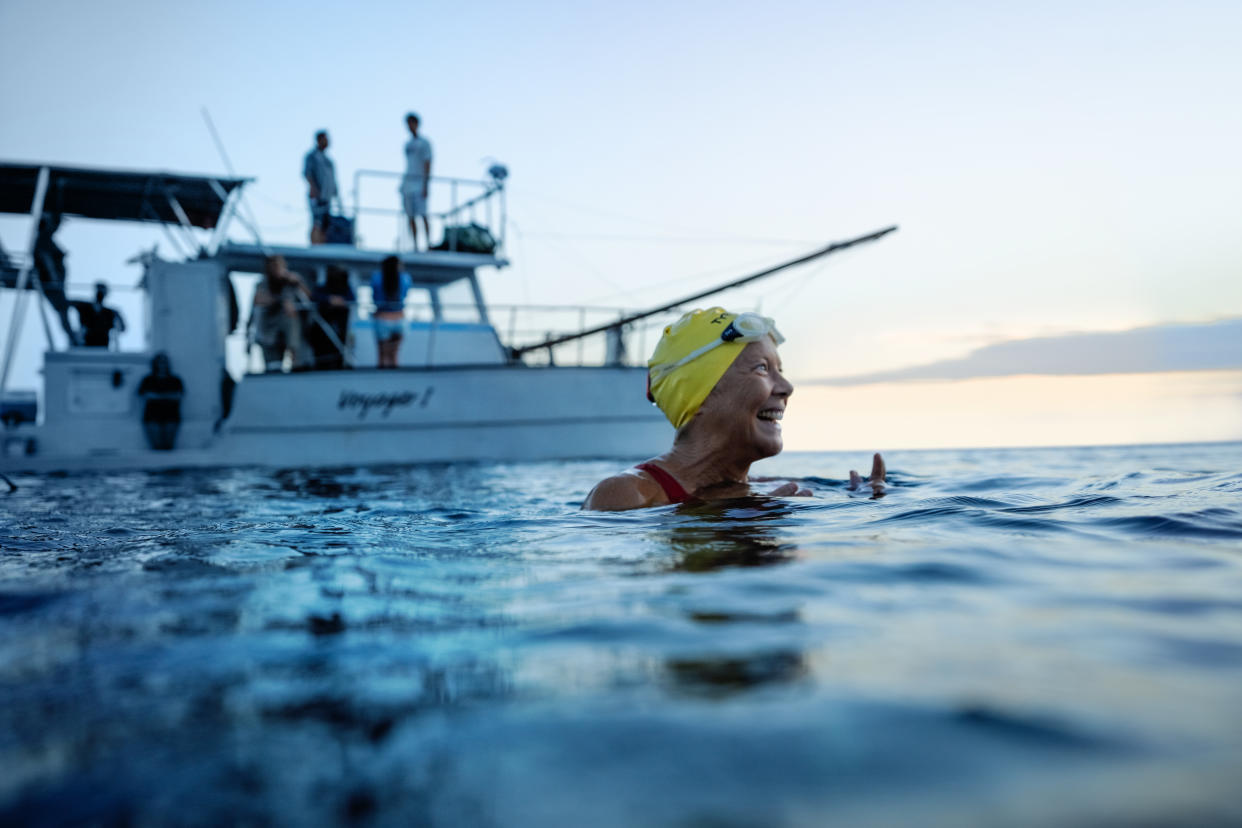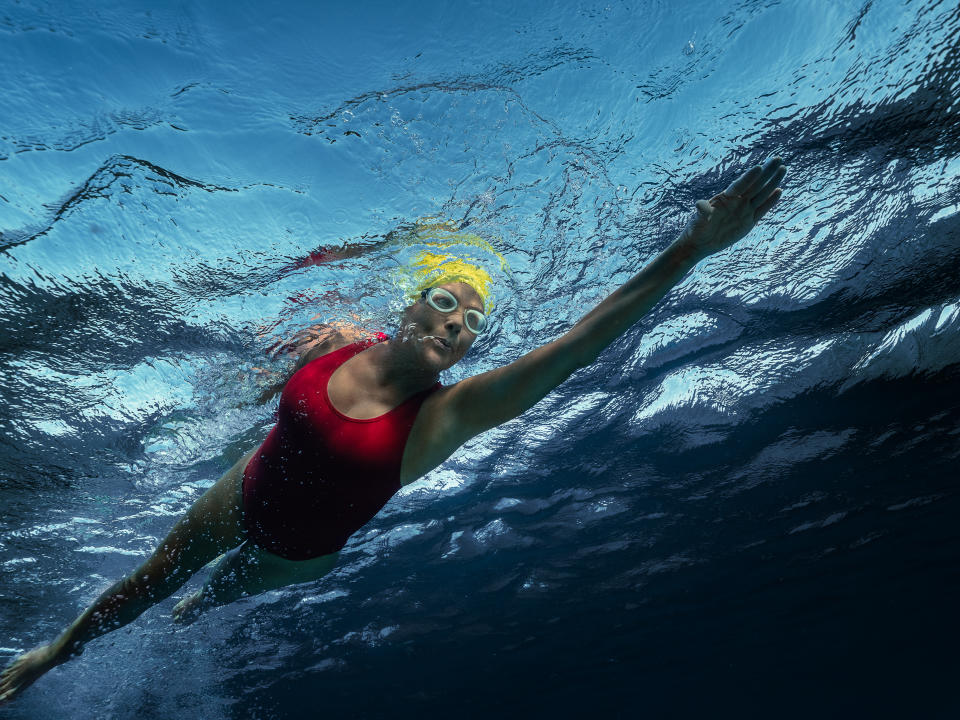‘Nyad’ Gets Its Visceral Power Thanks to Underwater Chemistry Between Annette Bening and the Cinematographer

- Oops!Something went wrong.Please try again later.
- Oops!Something went wrong.Please try again later.
Underwater cinematographer Peter Zuccarini has worked on some of the biggest movies of all time (“Avatar: The Way of Water,” the “Pirates of the Caribbean” series) and swam with sharks (“Into the Blue”) and crocodiles (“The Motorcycle Diaries”) to get his shots, so one might think that a modest character study about a 60-year-old swimmer trying to fulfill a youthful ambition wouldn’t have anything new to offer him. Yet according to Zuccarini, telling the true story of Diana Nyad (Annette Bening) and her 110-mile swim between Cuba and Florida in Netflix’s “Nyad” offered him satisfaction unlike any he had ever experienced on set.
“Watching the movie I was thinking to myself, ‘I have never done this before,'” Zuccarini told IndieWire. “I’ve never been able to move a camera around someone so closely.” Indeed, one of the great strengths of “Nyad” is the intimate access that it gives the viewer to Diana’s emotional experience in the water, an access Zuccarini credits partly to his small camera — a Sony Fx3 — but mostly to the commitment and trust of Bening. “I feel like the same way people talk about chemistry between actors, on this movie there was chemistry between me and Annette in terms of her trusting how I was going to move in the water with this camera — that I was going to be safe even though I was sometimes an inch away from her face.”
More from IndieWire
Directed by Jimmy Chin and Elizabeth Chai Vasarhelyi, “Nyad” reunited Zuccarini with “Life of Pi” director of photography Claudio Miranda, who shot his material with a Sony Venice 2. Where “Life of Pi” was a big-budget, well-resourced production, for “Nyad” Zuccarini and Miranda had to strip things down to their essence, an approach that yielded not only budgetary and logistical rewards but dramatic ones as Zuccarini landed on a method of capture that would allow him to swim with Bening as closely as possible. Although Zuccarini and his team have developed numerous underwater rigs that can move even the biggest cameras — and those cameras can move easily underwater because there’s no weight to them — it was decided that the tiny Fx3 was the way to go.

“We’ve found ways to move big cameras very effectively, but something people don’t think about is that a camera close to a body can push the water around and create turbulence — it can move someone without even touching them,” Zuccarini said. “So even if you have the technology to push a big camera from 3 feet to 3 inches really fast, you’re going to push the person before you even get there.” The fact that so much of “Nyad” focuses on Diana swimming created a challenge for the filmmakers, who knew the material could grow monotonous if it wasn’t as visceral and immediate as possible — hence the Fx3.
“We had conversations about how the small form factor would be really great for agility,” Zuccarini said. “Now maybe I could move without scuba gear because I’m an accomplished free diver. I’d be able to swim with the camera and do moves around her face, to her hands, to her hips, her feet, her eyeballs.” Zuccarini shot some tests with the Fx3 in his pool with his dog and kids, and Miranda was happy with the way the sensor looked but quickly pointed out that working with Bening in the tank where most of “Nyad” was shot would pose a whole other set of challenges. “When I got there I realized Annette was doing her own swimming, this is not a body double movie. It’s very much about her face and her body language, the cadence of her stroke, the elation, the suffering, that she was singing songs to keep her mind from wandering…all of these things needed to be conveyed visually.”
Zuccarini was careful to keep his camera as close to Bening as possible without bumping her to keep from interfering with her rhythms. “Even if it doesn’t injure them, if an actor touches a camera when they’re not expecting to it’s like, ‘Wait a second, why is this camera so close to me?'” Zuccarini said. Luckily, the nature of the production inspired a close working relationship between the cameraman and Bening that Zuccarini feels is often singular to water photography. “There’s a unique kind of intimacy that gets created between the water team and actors that doesn’t happen with a normal crew on land. On land, if someone is doing a vigorous action take, they do it and then they’re left to their handlers — they go to their makeup and hair or their personal assistant who’s hovering around to see what their needs are. In water, they’re stripped of all that. We become their handlers.”
This situation became even more pronounced on “Nyad” as Bening chose to stay in the water as much as possible. “If it was going to take 10 minutes to change a lens, rather than get out and have tea and get warmed up, Annette said, ‘The energy it takes for me to swim across the tank, climb up the ladder, get in the cold wind that’s blowing…it’s just not worth it. I’m just going to be happy here in the water.'” That meant Bening spent several hours each day in the water with Zuccarini and his crew, and that built up a trust Zuccarini felt yielded a delicate dance between Bening and his camera. “There’s a lot of bonding, a lot of personal stories and anecdotes being told,” Zuccarini said. “So when you’re seeing vivid imagery of her facial expressions, it’s because the camera is 2 or 3 inches off her eyes and then pulling just a foot away to let her arm come through and then coming back. I’ve never been able to capture a swimmer moving as freely with the camera coming inside of their space like that, and that was the result of Annette and I trusting that we could be together that close while moving through the water.”
Zuccarini noted that it wasn’t just trust but Bening’s incredible stamina that made their work together so powerful. “She was doing no less than three hours of swimming a day and frequently up to six hours,” Zuccarini said. “Even for an athlete, it’s crazy. You know, other directors and crew members have tried to join us in the water. You get a director or a gaffer who says they want to be there for everything. And the first day up to lunchtime, they’re there, and they’re like, ‘This is great.’ We never see them again after lunch. It just takes too much out of you unless you’re conditioned for it. Annette came in ready. She knew she wanted this role and she worked with an Olympic swim coach for months. I knew from the first day that she wasn’t messing around.”
Best of IndieWire
The Best Thrillers Streaming on Netflix in November, from 'Fair Play' to 'Emily the Criminal'
Sofia Coppola Movies, Ranked: 'Priscilla,' 'The Virgin Suicides,' 'Marie Antoinette,' and More
Sign up for Indiewire's Newsletter. For the latest news, follow us on Facebook, Twitter, and Instagram.

